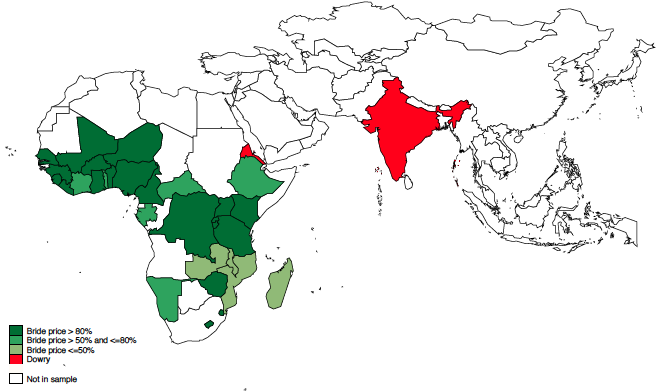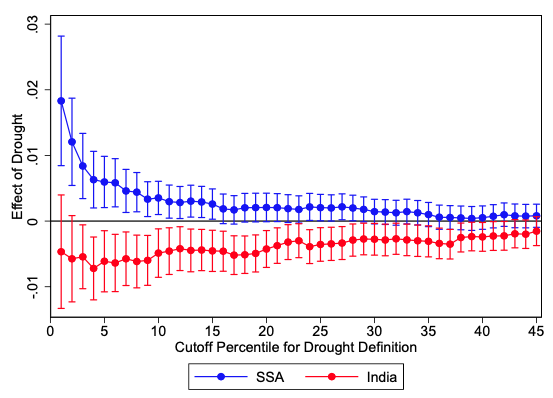
The age of marriage responds to economic conditions. Reducing child marriage requires understanding the economic role of culture and institutions
Marriage markets are an important determinant of human capital investments, risk-sharing opportunities, and fertility outcomes (Tertilt 2005, Field and Ambrus 2008, Chiappori et al. 2017, Chiappori et al. 2018). Across countries and over time, different trends in marriage behaviour, especially the age of marriage, are associated with different demographic outcomes and economic opportunities for women.
Child marriage – defined as marriage before the age of 18 – is correlated with higher rates of domestic violence; harmful effects on maternal, newborn, and infant health; reduced reproductive autonomy; and lower educational attainment (Jensen and Thornton 2003, Field and Ambrus 2008, Chari et al. 2017).
UNICEF estimates that 700 million women alive today were married before their 18th birthday, with 56% and 42% of these, respectively, in South Asia and sub-Saharan Africa (UNICEF 2014). In these two regions, there is also a persistent tradition of marriage payments. Throughout sub-Saharan Africa, it is customary for the groom or his family to pay a bride price to the bride's family; in South Asia, and in particular in India, the prevailing tradition is for the bride’s family to pay a dowry to the groom or his family at the time of marriage.
Economic shocks, marriage payments, and child marriage
In a recent paper (Corno et al. forthcoming), we investigate how economic shocks affect child marriage in India and sub-Saharan Africa. We study whether this relationship is influenced by traditional marriage payment norms. Marriage payments – i.e. bride price and dowry – are widespread around the world. Figure 1 shows the prevalence of bride price and dowry in the sample of countries we are using for the analysis.
Guided by a simple equilibrium model, we hypothesise that the presence of bride price or of dowry would have systematically different implications for the relationship between child marriage and economic shocks. When aggregate income is temporarily low, households prefer to bring forward (with bride price) or delay (with dowry) their daughter's marriage in order to consume the marriage transfer.
Figure 1

Drought as a measure of economic shocks in sub-Saharan Africa and India
Following prior literature (Dell et al. 2012, Burke et al. 2015), we measure economic shocks using variation in rainfall. Exploiting precipitation data produced by geographers at the University of Delaware covering terrestrial areas across the globe for the period 1900 to 2010, we construct a measure of local droughts as a calendar year rainfall below the 15th percentile of a location’s long-run rainfall distribution in sub-Saharan Africa and India.
This measure of drought is a good proxy for economic shocks, as seen when we combine the rainfall data with agricultural yields data on the main staple crops growing in the two regions from the Food and Agriculture Organization Corporate Statistical Database (FAOSTAT) and the World Bank India Agriculture and Climate Data Set. In sub-Saharan Africa, droughts reduce average yearly crops yields by 12%. Similarly, droughts reduce average yields of all the major crops cultivated in India by 16%.
Child marriage in sub-Saharan Africa and India
To measure child marriage, we assembled all the publicly-available Demographic and Health Surveys (DHSs) between 1994 and 2013 for sub-Saharan Africa, resulting in a total of 73 surveys across 31 countries. For India, we used the DHS collected in 1998. Across all the surveys, the information on a woman’s age at first marriage is collected retrospectively during the woman’s interview: women are asked to recall the age, month and year when they were first married.
Our final sample consists of 326,645 women in sub-SaharanAfrica and 66,466 women in India. The mean age at first marriage is only 18.6 years in sub-Saharan Africa and 17.7 years in India. A significant fraction of women are marrying before age 18: 44.7% and 54.1% in sub-Saharan Africa and India, respectively.
The findings
1. Drought increases child marriage in sub-Saharan Africa, but decreases it in India
In sub-Saharan Africa, girls who experience a drought between the ages of 12 and 17 years are 0.2–0.6 percentage points, or 2.3–3%, more likely to get married in the same year. In India, girls who experience a drought between the ages of 12 and 17 are 0.46-0.47 percentage points, or 4.2–4.3% less likely to get married in that same year.
Figure 2 shows the estimates of the effect of drought on the annual hazard for child marriage in sub-Saharan Africa and India. Each point on the horizontal axis represents a definition of drought based on rainfall below the percentile of rainfall in a grid cell (sub-Saharan Africa) or district (India) in a given year, relative to the fitted long-run rainfall distribution in that grid cell or district. The capped spikes show the 95% confidence intervals of the estimated coefficients.
Figure 2

2. The effect of drought on child marriage is significant only where marriage payment is the prevailing norm
The marriage payments that prevail in sub-Saharan Africa and India are likely responsible for the opposite effect of drought on child marriage. Marriage payments generate incentives for parents to time their children's marriage as a consumption-smoothing mechanism in opposite ways in response to negative shocks.
Within sub-Saharan Africa, we exploit historical heterogeneity in marriage payments across ethnic groups and show that the effect of drought on child marriage is statistically significant only where the bride price is the prevailing norm, according to the Atlas of Pre-Colonial Societies. In contrast, no statistically significant association between adverse rainfall shocks and child marriage emerges in countries with a low prevalence of bride price.
In areas where bride price is the prevalent historical mode of payment, households hit by negative income shocks encourage their daughters to marry before they reach adulthood, while there is no relationship between income fluctuations and child marriage in countries where bride price is not customary.
Similarly, within India, the negative effect of droughts on child marriage is strongest in the north for earlier cohorts and increases over time in the south, consistent with the spreading of dowry practices in the region (Caldwell et al. 1983, Srinivasan 2005, Chiplunkar and Weaver 2017).
Policy implications: Cash transfers and child marriage
The key conclusion of this study is that in developing countries, where marriage payments are customary, the age of marriage responds to changes in aggregate economic conditions. This suggests that there is a potential for policies to influence marriage markets, however, in complex ways that interact with culture.
These results speak to recent policy evaluations testing the role of cash or in-kind transfers to reduce child marriage around the world. Our findings suggest that transfers targeting girls and their families could have a different effect on marriage depending on the mode of marriage payments in place in different countries and ethnic groups. While transfer programmes in sub-Saharan Africa may decrease child marriage, they may have an opposite effect in countries where dowry payments are customary.
In line with our results, Baird (2011) found that unconditional cash transfers reduce child marriage in Malawi, but, to the best of our knowledge, there is no rigorous evidence of how unconditional cash transfers can affect early marriage in India. In contexts where dowry is prevalent, conditional cash transfers may be more effective, compared to unconditional transfers, as suggested by recent evidence (Sinha and Yoong 2009).
Conclusion: The role of culture and institutions
In sum, designing successful policies to reduce child marriage – a goal that has received increasing attention – requires understanding the economic role of culture and institutions. More generally, our findings point to the importance of culture and institutions in influencing the external validity of natural experiments and to the value of replicating empirical and experimental analyses in different contexts, to improve our understanding of the economic mechanisms behind empirical results.
References
Baird, S, C McIntosh, and B Özler (2011), “Cash or condition? Evidence from a cash transfer experiment”, The Quarterly Journal of Economics 126(4): 1709–1753
Burke, M, E Gong and K, Jones (2015), “Income Shocks and HIV in Africa”, Economic Journal 125(585): 1157–1189.
Caldwell, J, P Reddy, and P Caldwell (1983), "The Causes of Marriage Change in South India", Population Studies 37(3): 343–361.
Chiplunkar, G and J Weaver (2017), "Marriage Markets and the Rise of Dowry in India", Discussion Paper.
Chari, A, R Heath, A Maertens and F Fatima (2017), “The causal effect of maternal age at marriage on child wellbeing: Evidence from India”, Journal of Development Economics 127: 42–55
Chiappori, P A, M C Dias and C Meghir (2018), “The marriage market, labor supply and education choice”, Journal of Political Economy 126(S1).
Chiappori, P A, B Salanié and Y Weiss (2017), “Partner choice and the marital college premium: Analyzing marital patterns over several decades”, The American Economic Review 107(8): 2109–67.
Corno, L, N Hildebrandt and A Voena, “Age of Marriage, Weather Shocks, and the Direction of Marriage Payments”, Econometrica, forthcoming.
Dell, M, B Jones and B Olken (2012), “Temperature Shocks and Economic Growth: Evidence from the Last Half Century”, American Economic Journal: Macroeconomics 4(3): 66–95.
Field, E and A, Ambrus (2008), “Early Marriage, Age of Menarche and Female Schooling Attainment in Bangladesh”, Journal of Political Economy 116(5): 881–930.
Jensen, R and R Thornton (2003), “The Consequences of Early Marriage in the Developing World”, Oxfam Journal of Gender and Development 11(2): 9–19.
Sinha, N and J, Yoong (2009), "Long-term financial incentives and investment in daughters: Evidence from conditional cash transfers in North India", The World Bank.
Srinivasan, S (2005), "Daughters or dowries? The changing nature of dowry practices in South India", World Development 33(4): 593–615.
Tertilt, M (2005), “Polygyny, fertility, and savings”, Journal of Political Economy 113(6): 1341–1371.
UNICEF (2014), “No time to lose: New UNICEF data show need for urgent action on female genital mutilation and child marriage”, press release.


